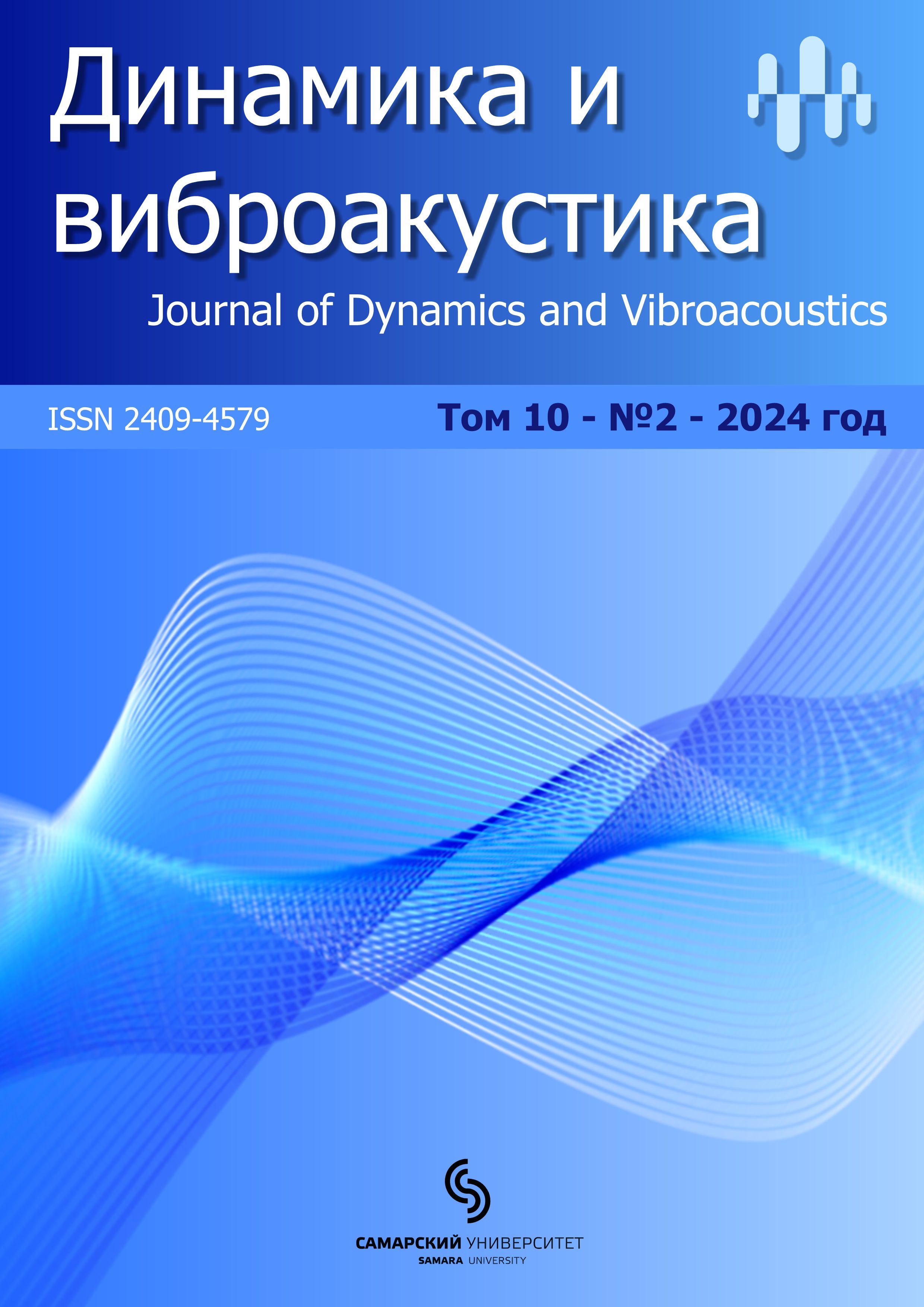Development of linear bearing equipment for modal testing of low-frequency weakly damped spacecraft structures
- Authors: Maksimov V.N.1, Marinin D.A.1, Maksimov P.N.1, Nazar'ko A.V.1
-
Affiliations:
- Academician M. F. Reshetnev Information Satellite Systems JSC
- Issue: Vol 10, No 2 (2024): 7.10.2024
- Pages: 59-69
- Section: Articles
- Published: 07.10.2024
- URL: https://dynvibro.ru/dynvibro/article/view/27852
- DOI: https://doi.org/10.18287/2409-4579-2024-10-2-59-69
- ID: 27852
Cite item
Full Text
Abstract
This article presents the results of a study of the bearing capacity and dissipative properties of an aerostatic linear bearing developed at JSC RESHETNEV for modal testing of complex structures. When selecting equipment for modal testing, the main condition is the requirement to minimize the distortions introduced into the determined dynamic characteristics: frequencies of natural vibration modes, the vibration modes themselves, as well as modal masses and damping coefficients. In other words, all equipment used for ground-based modal testing should ideally have zero added mass, stiffness and friction. The main systems containing elements that create dissipative forces that affect the determination of damping coefficients are systems for weight compensation and vibration excitation on natural modes. The weight compensation system usually contains either elastic elements or a system of guides with rolling or sliding bearings. If the former bring additional rigidity and mass to the test object, the latter bring mass and friction (dry or viscous), which increases the error in determining the dynamic characteristics. The excitation of vibrations on natural modes, in most cases, is carried out by electrodynamic vibrators consisting of a magnetization coil (or permanent magnet) and a movable coil moving in a magnetic gap. The movable coil is oriented in the magnetic gap using a special system containing either elastic elements or a linear guide bearing. Vibrators with elastic coil suspension elements cannot be used for modal tests of extended structures with low rigidity. The problem of creating an ideal bearing to replace classic linear (sliding or roller) ones arose during preparation for modal tests of the wing of a solar battery of a spacecraft (SC). Aerostatic bearings (supports) have virtually zero friction and sufficient load-bearing capacity, in which compressed air acts as a lubricant, eliminating physical contacts of the interacting surfaces. To confirm the possibility of using aerostatic bearings in equipment for conducting modal tests of extended structures with low frequencies of natural oscillations, comparative tests of a roller and aerostatic bearing were carried out. During the tests, optimal air flow parameters (nozzle diameter, operating pressure and gap) were selected, which ensure the required load-bearing capacity for radial forces and torques (bending and torsion). A comparative assessment of dissipative properties was carried out when measuring the attenuation parameters of single-mass harmonic oscillators, which include aerostatic and roller linear bearings. With a nozzle diameter of 0.6 mm, a working gap of 40 μm and a bearing input pressure of 1.0 bar, the logarithmic decrement of oscillations of the harmonic oscillator with an aerostatic bearing was 0.084, which is more than 28 times lower than the logarithmic decrement of oscillations of an oscillator with a roller bearing. The conducted studies confirmed the possibility of using the developed aerostatic bearing in test systems used in modal tests of large-sized transformable spacecraft structures.
About the authors
Valentin N. Maksimov
Academician M. F. Reshetnev Information Satellite Systems JSC
Author for correspondence.
Email: maksimovvn@iss-reshetnev.ru
Engineer
Russian Federation, Zheleznogorsk, Krasnoyarsk Territory, Russian FederationDmitriy A. Marinin
Academician M. F. Reshetnev Information Satellite Systems JSC
Email: marininda@iss-reshetnev.ru
Candidate of Technical Sciences, Head of the Department of testing static and dynamic strength
Russian Federation, Zheleznogorsk, Krasnoyarsk Territory, Russian FederationPavel N. Maksimov
Academician M. F. Reshetnev Information Satellite Systems JSC
Email: maksimovpn@iss-reshetnev.ru
Engineer
Russian Federation, Zheleznogorsk, Krasnoyarsk Territory, Russian FederationAleksey V. Nazar'ko
Academician M. F. Reshetnev Information Satellite Systems JSC
Email: nazarkoav@iss-reshetnev.ru
Engineer
Russian Federation, Zheleznogorsk, Krasnoyarsk Territory, Russian FederationReferences
- Aviatabile P. D. (2018), Modal tests. A guide for the practitioner, University of Massachusetts Lowell.
- Zaveri, K. (1985), Analysis of vibration modes of large structures – systems with several vibration stands [Text], Bruel & Kjer.
- Zhukov, E. P., Malenkova, V. V., Marinin, D. A. and Burns, V. A. (2017), "Sposob identifikatsii parametrov sobstvennykh tonov kolebaniy po rezul'tatam modal'nykh ispytaniy" [Method for identifying the parameters of natural vibration tones based on the results of modal tests] [Text], Proceedings of the Russian National Conference of Young Scientists with International Participation "XVII Korolev’s readings" dedicated to the 35th anniversary of the RSTS “Energia-Buran” spaceflight, vol. 1, pp. 94-95. (In Russian).
- Mikishev, G. N., Pronin, N. D., Shveyko, Yu. Yu. [et al.] (1970), "Ocenka effektivnosti nekotoryh eksperimental'nyh metodov opredeleniya osnovnyh dinamicheskih harakteristik uprugih konstrukciy" [Evaluation of the effectiveness of some experimental methods for determining the basic dynamic characteristics of elastic structures] [Text], Research on the theory of structures, Stroyizdat, Moscow, no. 10, pp. 85-100. (In Russian).
- Dryzhak, V. B., Verkhoglyad, A. G., Yemelyanov, E. L., Makarov, S. N., Marinin, D. A. and Matyukha, N. V. (2019), Sposob obezveshivaniya i vozbuzhdeniya kolebaniy pri modal'nyh ispytaniyah i ustroystvo dlya ego osushchestvleniya [A method for dewatering and exciting vibrations during modal tests and a device for its implementation], Russian Federation, Pat. 2677942. (In Russian).
- Gressema, N. S. and Powell, J. W. (1966), Bearings with gas lubrication, Mir. (In Russian).
- Sheinberg, S. A., Zhed’, V. P. and Shisheev, M. D. (1969), Opory skol’zheniya s gazovoy smazkoy [Sliding bearings with gas lubrication], Mashinostroenie [Mechanical Engineering].
- Poshekhonov, R. A., Guskov, A. M. (2013), "Vliyanie neodnorodnosti pronicaemosti ogranichiteley nadduva na harakteristiki ploskih aerostaticheskih opor" [The influence of inhomogeneity of the permeability of boost limiters on the characteristics of flat aerostatic supports], Science and Education, Bauman Moscow State Technical University, 08.08.2013.
- Stanogin, A. A. (2012), "Issledovanie harakteristik gazostaticheskih opor dlya shpindel'nyh uzlov" [Study of charac-teristics of gas-static supports for spindle units], Siberian Federal University.
- Poshekhonov, R. A. (2012), "Raschet sfericheskih aerostaticheskih opor pri zadannom smeshchenii i skorosti shpindelya" [Calculation of spherical aerostatic supports at a given displacement and spindle speed], Science and Educa-tion, Bauman Moscow State Technical University, 10.10.2012.
Supplementary files







